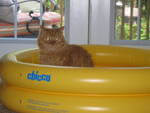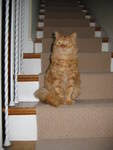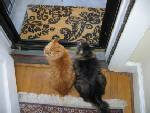
Linus, a six-year-old neutered male cat was brought in when his owner noticed him making multiple trips to the litter box. He would position himself as if trying to urinate but nothing would come out. While he did this, he cried, which his owner thought was unusual behavior.
 On presentation Linus was moderately dehydrated, slightly depressed and his heart rate was lower than I would have liked at 180 beats per minute. During abdominal palpation I was able to feel a very large, hard bladder and determined that he had a urinary obstruction. After quickly placing an intravenous catheter we collected blood to check his electrolyte status.
On presentation Linus was moderately dehydrated, slightly depressed and his heart rate was lower than I would have liked at 180 beats per minute. During abdominal palpation I was able to feel a very large, hard bladder and determined that he had a urinary obstruction. After quickly placing an intravenous catheter we collected blood to check his electrolyte status.
The potassium in his blood was dangerously high, which can lead to cardiac arrhythmias and rapidly result in death. We started Linus on IV fluids and gave him a medication to help lower his potassium. Because he was unable to urinate, the waste products normally excreted in urine were building up and making him feel sick.
I performed a cystocentesis which involves sticking a needle into his bladder to remove the urin e and relieve some of his discomfort. Because urinary obstruction is very painful for kitties, Linus was also given pain medication. X-rays showed he had stones in his bladder causing the obstruction. In male cats (and also male dogs), the urethra is very narrow, so it’s easy for things to get stuck in it. Stones are not the only cause of urinary obstructions in cats; mucus plugs, inflammatory cells, and crystals can also a blockage.
e and relieve some of his discomfort. Because urinary obstruction is very painful for kitties, Linus was also given pain medication. X-rays showed he had stones in his bladder causing the obstruction. In male cats (and also male dogs), the urethra is very narrow, so it’s easy for things to get stuck in it. Stones are not the only cause of urinary obstructions in cats; mucus plugs, inflammatory cells, and crystals can also a blockage.
I used an injectable anesthetic agent to sedate Linus so a urinary catheter could be passed. This was necessary for many reasons. First, he needed to be able to empty his bladder. We also needed to start him on intravenous fluids to flush out his system. This would decrease the dangerously high levels of potassium and waste products he had been unable to eliminate. And finally, given Linus’s current state, he was at an increased risk for general anesthesia, so I wanted to stabilize him before going to surgery.
The next morning, Linus went to surgery to have the stones removed via a cystotomy. He was sent home the next day. Analysis revealed that his stones were struvite. This was great news, because this type of urolith responds very well to diet change and has a low level of recurrence. Linus started his new prescription diet and his owners report he is like a new cat at home.
Urinary obstruction is incredibly common and can quickly become fatal, so it’s important for all owners of male cats to be aware of the condition and its symptoms. If you ever notice your cat making multiple trips to the litter box, straining to urinate and vocalizing, please bring him in immediately.

 On presentation Linus was moderately dehydrated, slightly depressed and his heart rate was lower than I would have liked at 180 beats per minute. During abdominal palpation I was able to feel a very large, hard bladder and determined that he had a urinary obstruction. After quickly placing an intravenous catheter we collected blood to check his electrolyte status.
On presentation Linus was moderately dehydrated, slightly depressed and his heart rate was lower than I would have liked at 180 beats per minute. During abdominal palpation I was able to feel a very large, hard bladder and determined that he had a urinary obstruction. After quickly placing an intravenous catheter we collected blood to check his electrolyte status.The potassium in his blood was dangerously high, which can lead to cardiac arrhythmias and rapidly result in death. We started Linus on IV fluids and gave him a medication to help lower his potassium. Because he was unable to urinate, the waste products normally excreted in urine were building up and making him feel sick.
I performed a cystocentesis which involves sticking a needle into his bladder to remove the urin
 e and relieve some of his discomfort. Because urinary obstruction is very painful for kitties, Linus was also given pain medication. X-rays showed he had stones in his bladder causing the obstruction. In male cats (and also male dogs), the urethra is very narrow, so it’s easy for things to get stuck in it. Stones are not the only cause of urinary obstructions in cats; mucus plugs, inflammatory cells, and crystals can also a blockage.
e and relieve some of his discomfort. Because urinary obstruction is very painful for kitties, Linus was also given pain medication. X-rays showed he had stones in his bladder causing the obstruction. In male cats (and also male dogs), the urethra is very narrow, so it’s easy for things to get stuck in it. Stones are not the only cause of urinary obstructions in cats; mucus plugs, inflammatory cells, and crystals can also a blockage.I used an injectable anesthetic agent to sedate Linus so a urinary catheter could be passed. This was necessary for many reasons. First, he needed to be able to empty his bladder. We also needed to start him on intravenous fluids to flush out his system. This would decrease the dangerously high levels of potassium and waste products he had been unable to eliminate. And finally, given Linus’s current state, he was at an increased risk for general anesthesia, so I wanted to stabilize him before going to surgery.
The next morning, Linus went to surgery to have the stones removed via a cystotomy. He was sent home the next day. Analysis revealed that his stones were struvite. This was great news, because this type of urolith responds very well to diet change and has a low level of recurrence. Linus started his new prescription diet and his owners report he is like a new cat at home.
Urinary obstruction is incredibly common and can quickly become fatal, so it’s important for all owners of male cats to be aware of the condition and its symptoms. If you ever notice your cat making multiple trips to the litter box, straining to urinate and vocalizing, please bring him in immediately.









You are linked to my blog. Hope you get some new readers. I will tell my sister about your cat posts. She always seems to have some cat issues. Hope you are doing well. xo
ReplyDelete